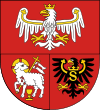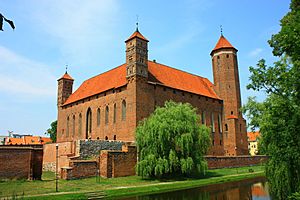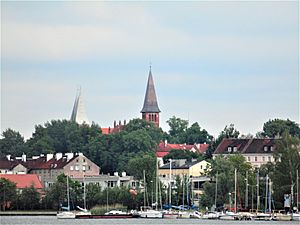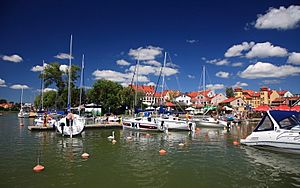Warmian–Masurian Voivodeship facts for kids
Quick facts for kids
Warmian–Masurian Voivodeship
Województwo warmińsko-mazurskie
|
|||||
|---|---|---|---|---|---|
|
|||||
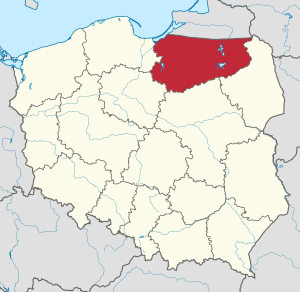
Location within Poland
|
|||||

Division into counties
|
|||||
| Country | Poland | ||||
| Capital | Olsztyn | ||||
| Counties |
2 cities, 19 land counties *
Elbląg
Olsztyn Bartoszyce County Braniewo County Działdowo County Elbląg County Ełk County Giżycko County Gołdap County Iława County Kętrzyn County Lidzbark County Mrągowo County Nidzica County Nowe Miasto County Olecko County Olsztyn County Ostróda County Pisz County Szczytno County Węgorzewo County |
||||
| Government | |||||
| • Body | Executive board | ||||
| Area | |||||
| • Total | 24,191.8 km2 (9,340.5 sq mi) | ||||
| Population
(2019)
|
|||||
| • Total | 1,425,967 | ||||
| • Density | 58.94423/km2 (152.6649/sq mi) | ||||
| • Urban | 844,177 | ||||
| • Rural | 581,790 | ||||
| ISO 3166 code | PL-28 | ||||
| Vehicle registration | N | ||||
| HDI (2019) | 0.848 very high · 16th |
||||
|
|||||
The Warmian–Masurian Voivodeship is a region, or province, in northeastern Poland. It is also known as the Warmia–Masuria Province. Its capital city is Olsztyn, which is also its largest city.
This region covers about 24,192 square kilometers (9,341 sq mi). In 2019, around 1.4 million people lived here. The Warmian–Masurian Voivodeship was created on January 1, 1999. It was formed from parts of older provinces. Its name comes from two old historical areas: Warmia and Mazury.
The province shares borders with other Polish regions. To the east, it borders Podlaskie Voivodeship. To the south, it borders Masovian Voivodeship. To the southwest, it borders Kuyavian-Pomeranian Voivodeship. To the west, it borders Pomeranian Voivodeship. In the northwest, it touches the Vistula Lagoon. To the north, it borders the Kaliningrad Oblast, which is a part of Russia. This area largely matches the southern part of what used to be East Prussia. This land became part of Poland after World War II.
Contents
History of Warmian–Masurian Voivodeship
The Warmian–Masurian region has a long and interesting history. It was once home to an ancient group called the Old Prussians. The name Warmia comes from one of their clans, the Warmians.
Teutonic Knights and Polish Rule
The Teutonic Order, a group of knights, conquered the Old Prussians. The Pope gave this land to the Order. This area then became part of the State of the Teutonic Order. The Order encouraged German settlers to move to Warmia. Polish settlers from the Masovia region, called Masurians, also moved here. This is how the name Masuria came about. Over time, the Old Prussians blended in with the new settlers and their culture disappeared.
During the time of the Teutonic Knights, cities grew and the economy got stronger. This was thanks to the Hanseatic League, a powerful trading group. The Teutonic Order later fought against their former ally, the Kingdom of Poland. This started a long conflict. Poland then teamed up with Lithuania. In Masuria, the Poles and Lithuanians defeated the Order at the Battle of Grunwald.
These wars led to a rebellion by the people in Pomerelia and Warmia. They were tired of the many wars caused by the Teutons. They asked King Casimir IV Jagiellon to make their region part of Poland. After the Thirteen Years' War, the region stayed under Polish control. However, it was split into two parts. Elbląg and Warmia became direct parts of the Kingdom of Poland. Masuria became a Polish fief, controlled by the Teutonic Order.
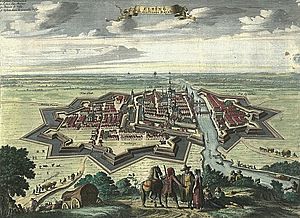
Changes and Modern Times
The Teutonic Order's state ended in 1525. Its Grandmaster, Albert Hohenzollern, made it a non-religious state called the Duchy of Prussia. He became a vassal, or loyal subject, of Sigismund I of Poland. The Hohenzollern family line in Prussia ended in 1618. The Duchy was then passed to the Brandenburg family. Prussia and Brandenburg became a personal union called Brandenburg-Prussia. It remained under Polish rule until 1660.
Later, Frederick I of Prussia wanted to combine the Duchy with Brandenburg. He also wanted to be called King of Prussia. So, he took part in the Partitions of Poland, which were led by Russia. In these partitions, Warmia was taken by the Kingdom of Prussia. It became part of the new province of East Prussia until 1945. This region then became part of the German Empire, the Weimar Republic, and Nazi Germany.
After World War II, many German and Slavic Masurian people were moved out of the area by the Polish government. In 1914, the province became a battlefield during World War I. Important battles like the Battle of Tannenberg took place here.
Cultural Heritage and Natural Beauty
One of the most visited places is the Masurian Lake District. It has over 2,000 lakes, including Poland's largest: Śniardwy and Mamry. Other famous landmarks include the Warmian castles, such as Lidzbark Warmiński Castle and Olsztyn Castle. The Cathedral Hill in Frombork is also famous. This is where the Polish astronomer Nicolaus Copernicus lived and worked. The Lidzbark Warmiński Castle was later home to Ignacy Krasicki, a famous Polish poet.
The Grunwald battlefield in Masuria hosts a yearly re-enactment of one of the biggest battles from the Middle Ages. Święta Lipka in Masuria and Gietrzwałd in Warmia are popular places for religious pilgrimages.
The Warmian–Masurian Voivodeship has the largest number of Ukrainians living in Poland. This is because of forced moves, like Operation Vistula, carried out by Soviet and Polish authorities in the past.
Cities and Towns of Warmian–Masurian Voivodeship
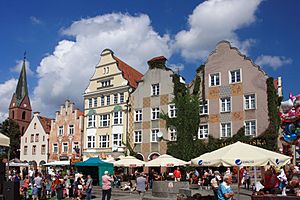
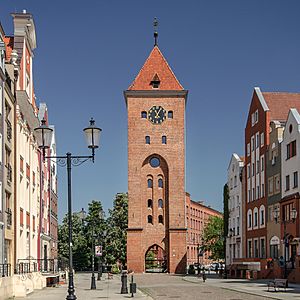
The Voivodeship has 3 cities and 47 towns. Here are the largest ones, based on their population in 2019:
Towns:
- Iława (33,322 people)
- Ostróda (32,947 people)
- Giżycko (29,335 people)
- Kętrzyn (27,212 people)
- Bartoszyce (23,482 people)
- Szczytno (23,267 people)
- Mrągowo (21,656 people)
- Działdowo (21,279 people)
- Pisz (19,277 people)
- Braniewo (17,040 people)
- Olecko (16,442 people)
- Lidzbark Warmiński (15,728 people)
- Morąg (13,793 people)
- Nidzica (13,762 people)
- Gołdap (13,716 people)
- Pasłęk (12,160 people)
- Węgorzewo (11,328 people)
- Nowe Miasto Lubawskie (10,891 people)
- Biskupiec (10,598 people)
- Lubawa (10,387 people)
- Dobre Miasto (10,208 people)
- Orneta (8,772 people)
- Lidzbark (7,794 people)
- Olsztynek (7,561 people)
- Barczewo (7,513 people)
- Susz (5,560 people)
- Orzysz (5,546 people)
- Reszel (4,532 people)
- Ruciane-Nida (4,454 people)
- Korsze (4,206 people)
- Biała Piska (4,024 people)
- Górowo Iławeckie (3,951 people)
- Mikołajki (3,826 people)
- Jeziorany (3,190 people)
- Wielbark (3,035 people)
- Ryn (2,851 people)
- Pieniężno (2,721 people)
- Tolkmicko (2,689 people)
- Miłakowo (2,548 people)
- Pasym (2,503 people)
- Miłomłyn (2,436 people)
- Bisztynek (2,370 people)
- Frombork (2,332 people)
- Zalewo (2,145 people)
- Kisielice (2,098 people)
- Sępopol (1,958 people)
- Młynary (1,772 people)
How the Region is Governed
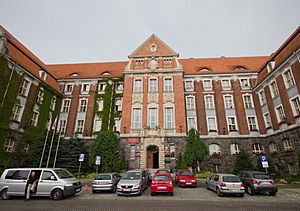
The Warmian–Masurian Voivodeship is divided into 21 main areas called powiaty (counties). Two of these are city counties, and 19 are land counties. These counties are then further divided into 116 smaller areas called gminas.
Here is a list of the counties, from most populated to least populated:
| English and Polish names |
Area (km2) |
Population (2019) |
Seat | Other towns | Total gminas |
| City counties | |||||
| Olsztyn | 88 | 172,194 | 1 | ||
| Elbląg | 80 | 119,760 | 1 | ||
| Land counties | |||||
| Olsztyn County powiat olsztyński |
2,840 | 126,334 | Olsztyn * | Dobre Miasto, Biskupiec, Olsztynek, Barczewo, Jeziorany | 12 |
| Ostróda County powiat ostródzki |
1,765 | 104,526 | Ostróda | Morąg, Miłakowo, Miłomłyn | 9 |
| Iława County powiat iławski |
1,385 | 92,933 | Iława | Lubawa, Susz, Kisielice, Zalewo | 7 |
| Ełk County powiat ełcki |
1,112 | 91,446 | Ełk | 5 | |
| Szczytno County powiat szczycieński |
1,933 | 69,678 | Szczytno | Pasym, Wielbark | 8 |
| Kętrzyn County powiat kętrzyński |
1,213 | 62,536 | Kętrzyn | Reszel, Korsze | 6 |
| Działdowo County powiat działdowski |
953 | 65,288 | Działdowo | Lidzbark | 6 |
| Bartoszyce County powiat bartoszycki |
1,309 | 57,642 | Bartoszyce | Górowo Iławeckie, Bisztynek, Sępopol | 6 |
| Pisz County powiat piski |
1,776 | 56,328 | Pisz | Orzysz, Ruciane-Nida, Biała Piska | 4 |
| Giżycko County powiat giżycki |
1,119 | 56,661 | Giżycko | Ryn | 6 |
| Elbląg County powiat elbląski |
1,431 | 57,395 | Elbląg * | Pasłęk, Tolkmicko, Młynary | 9 |
| Mrągowo County powiat mrągowski |
1,065 | 49,970 | Mrągowo | Mikołajki | 5 |
| Braniewo County powiat braniewski |
1,205 | 41,223 | Braniewo | Pieniężno, Frombork | 7 |
| Nowe Miasto County powiat nowomiejski |
695 | 43,900 | Nowe Miasto Lubawskie | 5 | |
| Lidzbark County powiat lidzbarski |
924 | 41,311 | Lidzbark Warmiński | Orneta | 5 |
| Olecko County powiat olecki |
874 | 34,281 | Olecko | 4 | |
| Nidzica County powiat nidzicki |
961 | 32,940 | Nidzica | 4 | |
| Gołdap County powiat gołdapski |
772 | 26,825 | Gołdap | 3 | |
| Węgorzewo County powiat węgorzewski |
693 | 22,796 | Węgorzewo | 3 | |
| * seat not part of the county | |||||
Tourism and Nature in Warmian–Masurian Voivodeship
This region is a great place to visit! You can explore old palaces and Gothic castles. Many of these were once homes for the Teutonic Order or important church leaders. Gothic churches like the Archcathedral of Frombork and the church in Dobre Miasto are beautiful. They have unique architectural details.
At the Warmia and Mazury Museum in Olsztyn, you can see many items from when Nicolaus Copernicus lived in Warmia.
Protected Natural Areas
The Warmian–Masurian Voivodeship has many protected natural areas. There are eight special areas called Landscape Parks:
- Brodnica Landscape Park (partly in Kuyavian-Pomeranian Voivodeship)
- Dylewo Hills Landscape Park
- Elbląg Upland Landscape Park
- Górzno-Lidzbark Landscape Park (partly in Kuyavian-Pomeranian and Masovian Voivodeships)
- Iława Lake District Landscape Park (partly in Pomeranian Voivodeship)
- Masurian Landscape Park
- Puszcza Romincka Landscape Park
- Wel Landscape Park
The Łuknajno Lake nature reserve is part of the Masurian Landscape Park. It is a protected wetland under the Ramsar convention. It is also recognized by UNESCO as a biosphere reserve.
Images for kids
-
Brick Gothic fortified cathedral in Frombork, burial place of astronomer Nicolaus Copernicus
-
St. James' Cathedral in Olsztyn
-
Palace in Smolajny, former summer residence of Ignacy Krasicki
-
Grunwald battlefield
See also
 In Spanish: Voivodato de Varmia y Masuria para niños
In Spanish: Voivodato de Varmia y Masuria para niños



